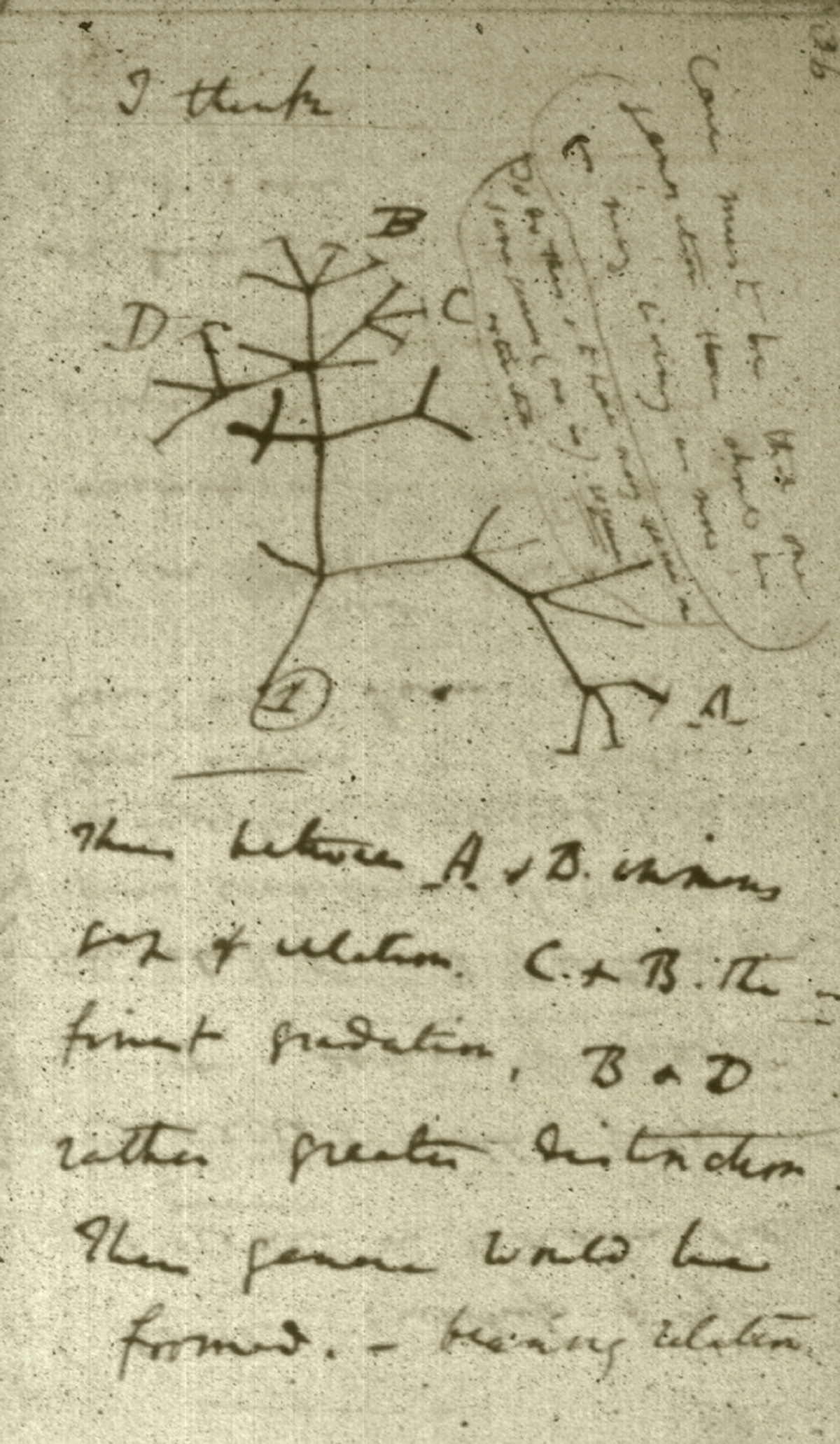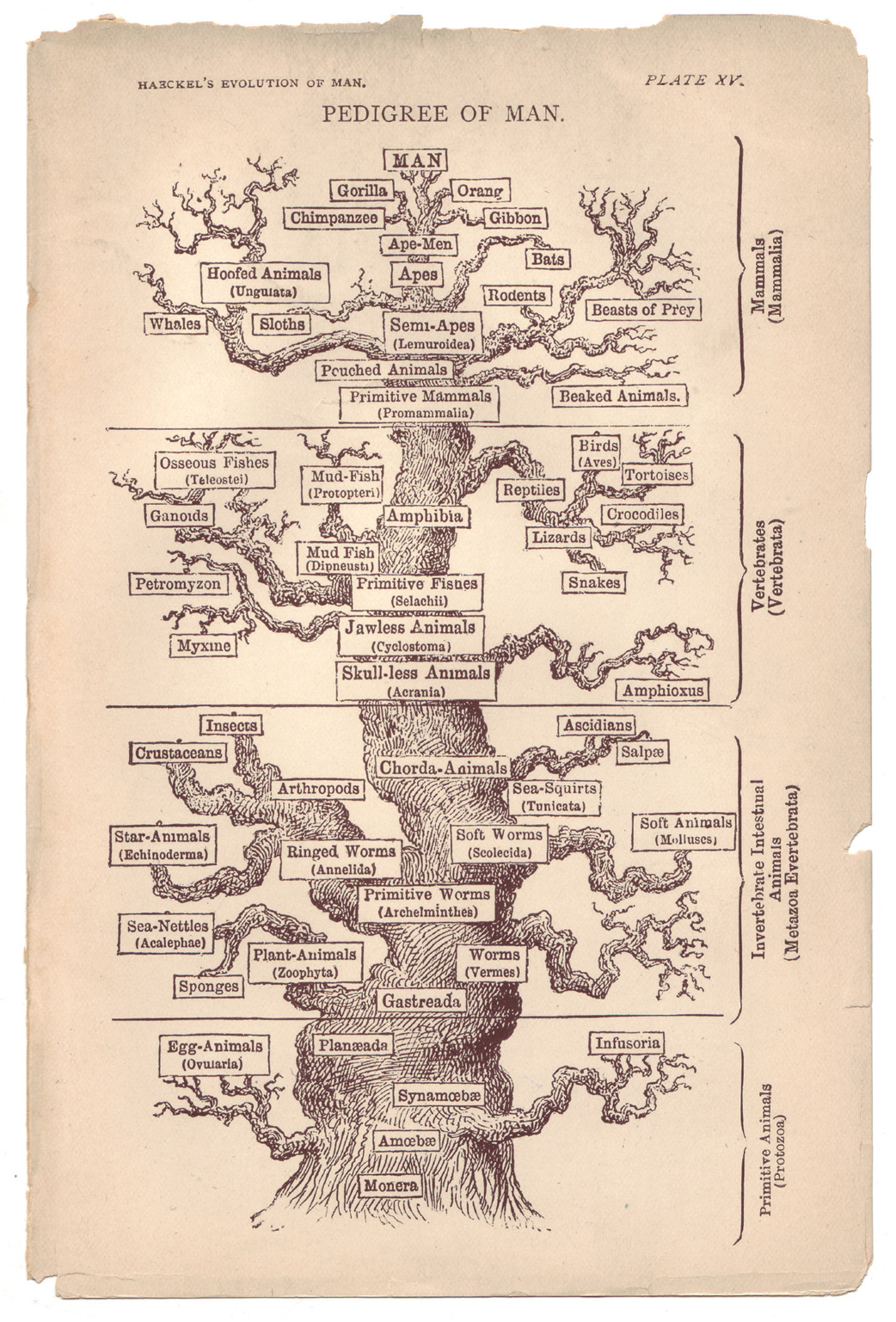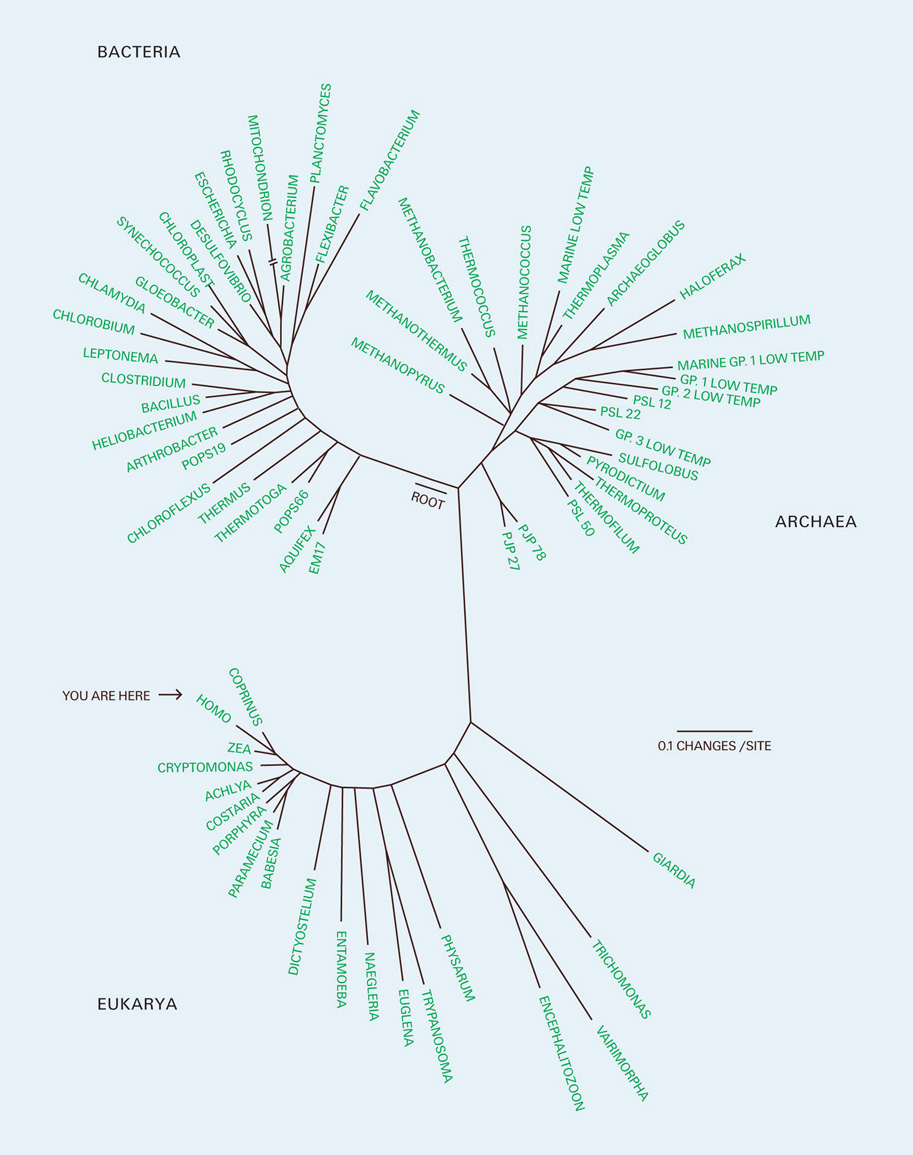Figuring Life
Redrawing Darwin’s evolutionary tree
Margaret Wertheim
In 1859 when Charles Darwin published On the Origin of Species by Means of Natural Selection, the book was adorned with a single illustration—a filigreed configuration that resembled the branching shoots of a plant set against a background of ruled and numbered lines. The diagram was an elaboration of a sketch Darwin had first doodled in one of his private notebooks in 1837, and it represented an idea that now seems almost impossible to banish from our mental landscape—the evolutionary Tree of Life.
Through his painstaking studies of morphological transformations in human-bred species such as pigeons and bulldogs, and his observations of the changing characteristics of Galapagos finches and so on, Darwin had come to believe that the history of life on Earth could be modeled as a tree, the branches representing the species, genera, and other orders of beings. He expressed his thoughts with typical poetic languor in the 1872 edition of the Origin of Species:
The affinities of all beings of the same class have sometimes been represented by a great tree. I believe this simile largely speaks the truth. The green and budding twigs may represent existing species; and those produced during former years may represent the long succession of extinct species. … As buds give rise by growth to fresh buds, and these, if vigorous, branch out and overtop on all sides many a feebler branch, so by generation I believe it has been with the great Tree of Life, which fills with its dead and broken branches the crust of the earth, and covers the surface with its ever-branching and beautiful ramifications.
Darwin’s description more evokes a thicket than a single stemmed plant—indeed, the 1837 sketch resembles a clump of thorns—but by 1866 the diagram itself had undergone an evolutionary transformation. In that year, Darwin’s great German popularizer Ernst Haeckel published in his General Morphology an image of life as a mighty oak with all living things emanating from the sturdy root of primitive protoplasmic organisms Haeckel called moneren. Here, Haeckel placed the origin of humans firmly within the branch of the Great Apes, where it has resided ever since. Haeckel’s Tree of Life encouraged his readers to see the evolution of species as a hierarchy, ascending upward, like an oak into the sky, from the almost formless protista towards the complex fruit of Man.
By the early twentieth century, the Tree of Life had been segmented into four major branches or “kingdoms”: animals, plants, fungi, and prokaryotes, a catchall term for the vast and largely undocumented swathes of microorganisms that have no cell nucleus—Haeckel’s moneren by another name.
For the past century biologists have argued about how exactly living things are historically related, and hence how they ought to be classified. In the 1960s, many taxonomists decided to abandon the old Linnaean system based on morphological similarity, or shared anatomical features, and to base their classification scheme entirely on the order of branching in evolutionary trees. They gave their new science the name cladistics, from the Greek word klados or “branch,” and called their evolutionary trees cladograms. Cladistics was an attempt to bring rigor to a field that had long been plagued by subjective judgment.

Aristotle, who remained the leading Western authority on zoological classification for two thousand years, had divided animals into those with blood and those without blood, or at least without red blood. It seems now an arbitrary division, but it parallels rather nicely the modern distinction between vertebrates and invertebrates—with or without spine. Aristotle’s “bloodless” animals were classified into cephalopods (such as the octopus); shelled animals (such as mollusks, spiders, scorpions, centipedes, and most of what we now call insects); and the zoophytes, or “plant animals” such as anemones and jellyfish that supposedly resembled plants. The blooded animals were separated into five major genera: the viviparous quadrupeds (our placental mammals), the oviparous quadrupeds (egg-laying creatures such as lizards and reptiles), birds, fish, and whales (along with dolphins and porpoises). Despite Aristotle’s separation of the latter group, until recently whales and dolphins have mostly been classified as fish. In the early nineteenth century, there was a court case about the taxonomic designation of whales, which have since been grouped with the land-based mammals.
Cladistics, too, remains a subjective science, for all its aspirations to objectivity and its fancy designation as “phylogenetic systematics.” Cladograms are merely proposals for evolutionary relationships based on some chosen set of morphological features; thus if you and I choose different sets of features to track, then our cladograms will very likely differ. In recent years, however, the science of classification has been transformed by the tools of DNA analysis, which allows taxonomers to eschew anatomy entirely. The new classifiers do not care whether an organism has warm blood or cold blood, or any blood at all. It is irrelevant to them whether a species walks or flies or crawls or swims, or whether it lays eggs. The DNA analyzers have no interest in how organisms behave or what they look like. Their sole taxonomical quantifier is a living thing’s genes, and, using this molecular tool, they have redrawn the scientific picture of life on Earth.
The New Tree of Life does not look like a tree at all, but like a pinwheel. Three arms spiral out from a central “root” representing three major living “domains”—the eukarya, the bacteria, and the archaea. Most of the organisms mapped here are invisible to the naked eye, for almost all life on Earth is microscopic. Yet within each of these domains are creatures as different from one another as a giraffe is from a mushroom.
Of the four kingdoms mapped in the classic Tree of Life, three—animalia, plantae, and fungi—occupy just one tiny part of the eukaryotic domain. All plants and animals and fungi are represented in this new diagram by the three small branches in the lower left arm of the spiral. Coprinus, a kind of mushroom, stands in here for all fungi; Homo, for Homo sapiens, stands here for all animals; and Zea, maize, stands for all plants. These three tiny shoots are all that remains of Haeckel’s original tree.
The diagram has been drawn up by Dr. Norman Pace, at the Department of Molecular, Cellular and Developmental Biology, the University of Colorado at Boulder, a leader in the new field of molecular mapping of evolutionary relationships. Unlike prior versions of the Tree of Life, Pace’s map has been drawn without recourse to subjective judgments about how things look. Relationships here are based purely on the degree of similarity between various organisms’ DNA—the length of the branches represents “genetic distance” so that the farther apart two organisms are, the more different is their DNA. Or as Pace likes to say, “This is a map of molecular machinery.”

What matters in this new taxonomic scheme is the chemistry an organism engages in. Looked at from the level of cellular chemistry, animals and plants and fungi are very close siblings. All three share the basic architecture of eukaryotes—their cells have an enclosed nucleus, and in the cytoplasm surrounding the nucleus, there are other enclosed organelles such as chloroplasts (that enable plants to produce energy by photosynthesis) and mitochondria (that enable animals to produce energy from sugars). Even among the eukaryotes, plants and animals and fungi are a tiny subset of the group as a whole. The overwhelming bulk of life is microscopic organisms—what Pace calls “the little stuff out there.” Long overlooked by taxonomists on account of their miniscule size and the natural bias of animal-centric humans, “the little stuff” comes into its own under the glare of the molecular spotlight. Archaea in particular have been a source of surprise.
What makes archaea archaea? Simply that these organisms do different chemistry. Very different chemistry. “We eukaryotes make our cell membranes out of linked lipids,” Pace explains. “So do bacteria, but archaea do not.” Archaea transcribe DNA and RNA by quite another method that only became evident when they were studied at the genetic level. Telling the difference between archaea and bacteria is no simple task. Neither domain has a cell nucleus, and even under a microscope most biologists could not distinguish between the two groups. Archaea were only identified in the 1970s when a number of species were discovered in geothermal hot springs. Since then, biologists have come to understand that their chemical makeup and function are extremely different from bacteria. “Lumping together archaea and bacteria conceptually discounts fundamental differences between these two kinds of organisms,” Pace says.
“Have you ever farted?” he asks. “That’s archaea.” Archaea produce the excretions from cow guts and the off-gassing from rice paddies, both sources of methane that are significant contributors to the greenhouse gas content of our atmosphere. Archaea make landfills explode and are responsible for the red coloring in evaporation ponds. Many are methanogens, some are sulfanogens. Archaea are among the most abundant organisms on Earth and constitute perhaps ten percent of the planet’s biomass, turning our oceans into a fertile soup. Most of them have never been detected anywhere except in the blenders of Pace and his colleagues and we have no idea what they do in the natural world. These are the branches on the pinwheel that are labeled only with letters and numbers.
For sheer strangeness, archaea win hands down, but in sheer number of species, bacteria are king. They have the ability to transfer genes easily between species and can evolve at a far more rapid clip. Archaea, Greek for “the old ones,” are so-called because of all the three domains they have changed the least over time.
“Right now,” says Pace, “we are at the point with understanding the evolution of life where the science of chemistry was in the eighteenth century before Antoine Lavoisier.” In the coming decades, our view of the living realm will likely be revolutionized as we come to understand how truly marginal most of what we have long called “life” is within the grand scheme of nature.
What is so astounding when one looks at Pace’s diagram is that each branch of the bacteria and archaea represents a group of organisms that are as different from their neighbors as plants are from animals; and every one of these branches represents a wildly other class of organisms in relation to you and me. To quote a favorite Star Trek line: “It’s life Jim, but not as we know it.” No need to go to Mars to search for aliens—we are surrounded by them here on Earth.

Coprinus
A kind of mushroom; stands for all fungi, including yeasts and moulds.
Homo
Homo sapiens; stands here for all animals.
Zea
Maize; stands for all plants.
Porphyra
Red algae that live in the intertidal zone; it is the most commonly eaten seaweed and is used to make nori.
Paramecium
A group of unicellular ciliates, formerly known as “slipper animalcules.” Widespread in freshwater environments and especially common in pond scums.
Naegleria
Amoeba that causes meningitis.
Physarum
Slime mould.
Trichomonas
The species Trichomonas vaginalis is the most common pathogenic protozoan infecting humans in industrialized countries. The World Health Organization estimates that 180 million people are infected each year, almost all of them women. Trichomonas species are anaerobic (living without oxygen) and lack mitochondria.
Giardia
A flagellated waterborne protozoan parasite that infects the gastrointestinal tract, causing diarrhea. It is also one of the most common parasites infecting cats. Mammalian hosts include humans, cows, beavers, deer, dogs, and lambs. Cats can be easily cured; lambs usually just lose weight; but in calves, the parasites can be fatal, and in dogs it is particularly problematic. It is deadly to chinchillas and special care must be taken to provide them with safe drinking water.
Represents a sequence of genes that have been identified through DNA analysis, but the organism itself has never been knowingly encountered. Biologists have no idea what it does in the natural environment.
Pyrodictium
For a while, it held the record as the highest-temperature organism at 113 degrees Celsius. It eats hydrogen and breathes sulfur.
Haloferax
Organism that produces the red coloring in the huge evaporation ponds in San Francisco Bay and in the Great Salt Lake—hence it lends the pink tinge to waters surrounding Robert Smithson’s Spiral Jetty.
Methanococcus
Organism that produces the methane in cow farts and rice paddies.
Methanopyrus
Another organism that makes methane; it was discovered on the walls of a “black smoker” in the Gulf of California at a depth of two thousand meters.
Causes tumors in plants.
Escherichia
This is the “E” in E. coli. A genus of Gram-negative non-spore-forming, anaerobic, rod-shaped bacteria that inhabits the gastrointestinal tract of warm-blooded animals. Escherichia species provide vitamin K for their hosts and are useful for tracking fecal contamination in waterways.
Chlamydia
Causes genital and eye diseases.
Bacillus
Widely diverse group of rod-shaped bacteria that includes the organisms responsible for anthrax, botulism, tetanus, diphtheria—and yogurt
Chloroflexus
A genus of photosynthetic bacterium isolated from hot springs. In contrast to plants, they do not produce oxygen when they photosynthesize—their chemistry is based not on oxygen but on sulfur. The species Chloroflexus aurantiacus has an orange color when grown in the dark and a green color when grown in
sunlight.
Margaret Wertheim is founder and director of the Institute For Figuring, a Los Angeles-based organization dedicated to the aesthetic and poetic dimensions of science and mathematics. She is currently working on a book about outsider physics and the role of imagination in theoretical science.
Spotted an error? Email us at corrections at cabinetmagazine dot org.
If you’ve enjoyed the free articles that we offer on our site, please consider subscribing to our nonprofit magazine. You get twelve online issues and unlimited access to all our archives.